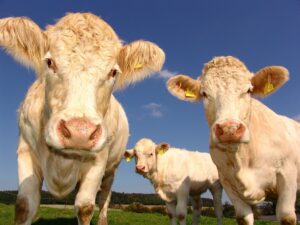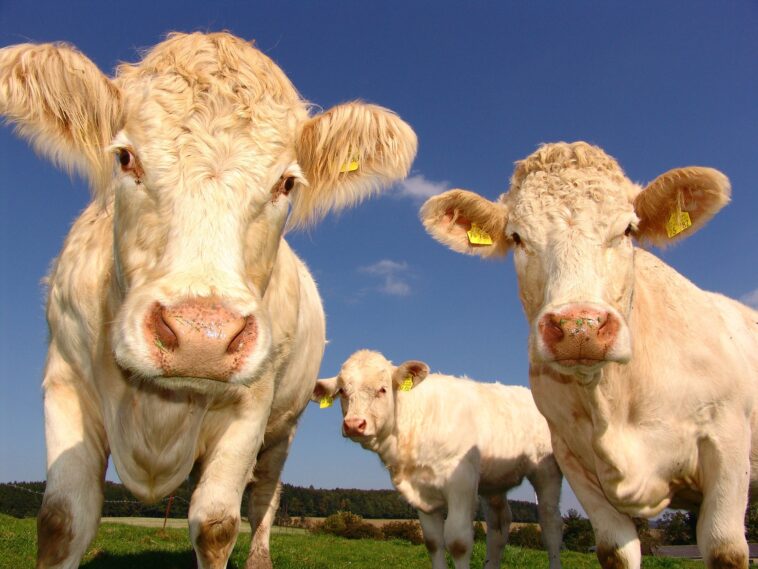Those with comparatively small farms will find miniature cattle to be ideal. This is because they tend to be an easy and safe alternative to conventional cattle and make for terrific grass-fed and organic beef products.
A single such animal, once butchered, will provide a convenient volume of meat to suit a smaller family, and it will also offer more of the high-quality cuts people usually desire. A so-called “mini cow” has the potential to keep a four-member family fed for up to six months. Mini milking cows are great for those who prefer cow’s milk and want to drink organically produced milk that is free from hormones.
These small cows have a size range at three years from roughly three feet in height to about four feet. This represents approximately one-half to about one-third of a typical cow’s size.
Because they are classified as herd animals, two to three acres of property could handle several mini cows. This type of livestock has a feed efficiency that is 25-30 percent greater than conventionally-sized cows. Mini cows and traditional cows have an identical gestation period of roughly 285 days.
 The increasing popularity of hobby and homestead farming has caused the population of mini cattle to grow, though they still represent a very small portion of the overall cattle tally in the United States. These breeds are well-loved in pastoral regions of developing countries and for a long time they were popular among the peasant farming ranks in Britain.
The increasing popularity of hobby and homestead farming has caused the population of mini cattle to grow, though they still represent a very small portion of the overall cattle tally in the United States. These breeds are well-loved in pastoral regions of developing countries and for a long time they were popular among the peasant farming ranks in Britain.
The cost of a mini cow is generally between $500 and $12,000 American dollars, with certain rare specimens costing upwards of $30,000. These days, over 20 breeds of mini cows exist, and the common varieties are generally much more affordable. It is often said that mini cows produce the “green” type of red meat.
Galloway Cows
Contents
These cattle have origins in Scotland and are known as especially hardy, yet friendly animals. These are also the oldest polled type of cows on the planet and are available in numerous colors, though black is most frequently seen. The double-layered hair they boast offers them great flexibility when it comes to climate. Their status as non-selective in their grazing habits allows them to be housed together with sheep. These cows are terrific with regard to milk production being that they are great mothers.
Dexter
This is a breed with origins in Ireland. These cows are typically half of a conventional Hereford’s size. A fully-grown cow will have a weight of roughly 600-700, with matured bulls weighing in at about 1,000 pounds. These cows come in a range of solid hues, with black most common. They also have horns. The Dexter breed is great for producing milk at levels of between 2 and 2.5 gallons daily, and they also produce lots of meat. They may also be used as oxen. Lots of mini cow breeds are the result of breeding Dexters with other varieties.
Zebu
The Zebu cow started out as a primitive animal of naturally small stature and is thought to date as far back as 6,000 B.C. in the southern regions of Asia. These cows are tropical in origin, making them slow maturers, but also disease resistant and quite hardy indeed. When raised in colder parts of the world, they will need to be kept in a barn. A mature Zebu cow ought to have a weight of 300-500 pounds, with bulls weighing up to 600 pounds. These cattle are seen in a range of different colors.
Jersey Cows
Mini versions of Jersey cows are able to produce roughly 2-3 gallons of milk daily. They require twice-a-day milking as well. It is necessary to lean rather low to the ground in order to get to this cow’s udders. A Jersey cow’s milk is known for its high composition of butterfat. Jersey’s have a happy demeanor and can live in warmer climates.
Panda Cows
This cow, also known as the “miniature panda” is an exceedingly rare breed that features a white belt, white face and black areas circling the eyes. Panda calves are able to command upwards of $30,000. It is thought that Panda cows are the product of a cross of Belted Galloways and Irish Dexters.
Herefords
These mini cows are the result of down breeding, or choosing the most diminutive livestock varieties for the purpose of breeding. These cows eat roughly half of what a full-sized cow would consume, and they produce about 50-75 percent of the meat volume. The weight of these cows ranges between 500-700 pounds. The United States is now home to at least 300 breeders of mini-Herefords, a massive increase from the merely 24 or so breeders that existed in the country in 2000.
Lowline Angus Cows
With its Australian origins, the lowline Angus is another example of successful “breeding down.” Typically, a Lowline Angus has a weight of 650-950 pounds and a height of 36-42 inches. Bulls weigh approximately 950-1350 pounds and have a stature of up to 46 inches. These cows are docile in nature, black in color and are known for easily calving. These cows are perfect for grass-fed beef production and renowned for the marbling of their meat.
Texas Longhorn Cows
Mini Texas Longhorn cows are also the result of breeding down and are about a third of the size of the conventional counterparts. These are well-suited to drier regions, are available in numerous colors, tend to have a gentle disposition and produce quality lean beef.
Highland Cows
Scottish Highland mini cows are thought to be relatively close to the size of their ancestors that lived on the Scottish Isles. A truly ancient breed, these cows are useful as oxen as well as for the production of dairy and beef products. These cows are stocky with a long coat and are respectably hardy. Their characteristics render them perfect for cold and/or mountainous climates.
Holstein Cows
These diminutive dairy cows are capable of generating roughly 2-3 gallons daily. There is no difference between the quality of milk from miniature and full-sized Holsteins. These cows are great for families who enjoy cows’ milk as opposed to goats’ milk and who also place a premium on organic products. Holsteins are black and white in color, have origins in the Netherlands and are perfect for grass-fed dairy production.



GIPHY App Key not set. Please check settings